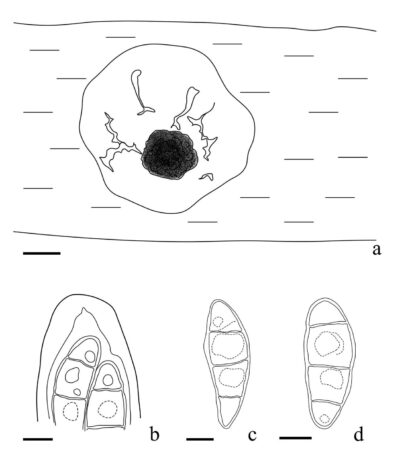Fungalpedia – Note 375, Zwackhiomacromyces
Zwackhiomacromyces Etayo & van den Boom
Citation when using this data: Tibpromma et al. 2024 (in prep.) – Fungalpedia, Lichenicolous fungi.
Index Fungorum, Facesoffungi, MycoBank, GenBank, Fig. 1
Classification: Xanthopyreniaceae, Collemopsidiales, Incertae sedis, Dothideomycetes, Pezizomycotina, Ascomycota, Fungi.
Based on conventional macro- and microscopic techniques, van den Boom and Etayo (2014) established Zwackhiomacromyces to accommodate the type species Zwackhiomacromyces constrictocarpus. Subsequently, Berger and Zimmermann (2016) synonym Pyrenidium hyalosporum under Zwackhiomacromyces (Z. hyalosporus), based on morphological studies. Zwackhiomacromyces as lichenicolous fungi with ascomata perithecioid, black, pyriform, branched and anastomosed pseudoparaphyses, fissitunicate asci, elongate-clavate, apically thickened and with an ocular chamber, and ellipsoid ascospores, hyaline, (2–)3-septate, smooth-walled, without a subapical germpore-like spot (van den Boom & Etayo 2014). No further species have been introduced to this genus, which remains as two species in Zwackhiomacromyces. In addition, this genus still lacks DNA sequences; there is a future need to re-collect fresh specimens.
Type species: Zwackhiomacromyces constrictocarpus Etayo & van den Boom
Other accepted species: Species Fungorum – search Zwackhiomacromyces
Figure 1 – Zwackhiomacromyces constrictocarpus. a Perithecia. b Ascus tip. c, d Ascospores. Scale bars: a = 0.1 mm; b-d = 10 µm. Redrawn from van den Boom and Etayo (2014).
References
Entry by
Du TY, Center for Yunnan Plateau Biological Resources Protection and Utilization, College of Biological Resource and Food Engineering, Qujing Normal University, Qujing, Yunnan 655011, China; Center of Excellence in Fungal Research, Mae Fah Luang University, Chiang Rai 57100, Thailand; School of Science, Mae Fah Luang University, Chiang Rai 57100, Thailand.
(Edited by Saowaluck Tibpromma, Samaneh Chaharmiri-Dokhaharani & Achala R. Rathnayaka)
Published online 25 November 2024
